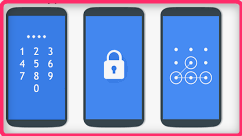If you have smartphones or tablets with fingerprint scanners, the ability to access
 your devices with a touch or swipe of your finger is a wonderful convenience.
Then again, this simplicity makes it easy to forget your password and PIN
number. This is a problem if your phone or tablet requires your PIN number on
its lock screen for some reason. Luckily, there are multiple ways to
remote unlock an Android.
your devices with a touch or swipe of your finger is a wonderful convenience.
Then again, this simplicity makes it easy to forget your password and PIN
number. This is a problem if your phone or tablet requires your PIN number on
its lock screen for some reason. Luckily, there are multiple ways to
remote unlock an Android.
 your devices with a touch or swipe of your finger is a wonderful convenience.
Then again, this simplicity makes it easy to forget your password and PIN
number. This is a problem if your phone or tablet requires your PIN number on
its lock screen for some reason. Luckily, there are multiple ways to
remote unlock an Android.
your devices with a touch or swipe of your finger is a wonderful convenience.
Then again, this simplicity makes it easy to forget your password and PIN
number. This is a problem if your phone or tablet requires your PIN number on
its lock screen for some reason. Luckily, there are multiple ways to
remote unlock an Android.
Remote Unlock Your Android
There are several ways to remote unlock Android
when you can't get past the lock screen. To gain access to your Android, either
reset your PIN or password remotely, root your phone to change its settings, or
reset the phone.
Google Find My Device
For years, the Google Find My Device web app made
it possible for users to change the lock screen PIN. This is no longer an
option. Now, it's only possible to use Find My Device to locate a
phone or tablet using the web or another device and to send a message to the
screen in case someone found your lost device.
This doesn't mean you won't be able to remote
unlock your Android. It just means that it won't be quite so easy. You still
have options.
Samsung Find My Mobile
If you own a Samsung Android phone or tablet, and
if you registered your device with your Samsung account, you're in luck.
Use Samsung Find My Mobile to reset the lock screen.
To enable remote, unlock on your Android with
Samsung Find My Mobile:
1. Open Settings on your
device.
2. Select Lock
Screen and Security. On some Samsung devices, you may need to select Security or Biometrics
and Security instead.
3. Select Find My Mobile.
4.
Select Add Account and sign into your Samsung account.
5.
Turn on the Remote controls toggle.
6.
To unlock your device, go to the Samsung Find My
Mobile web page and sign in.
7.
Select Unlock.
8.
The screen lock information on your device is deleted. This could be the
pattern, PIN, password, or biometrics that you originally set up.
Android Forgot My Password
If you're using an older version of Android,
specifically Android 4.4 KitKat and older, the ability to reset the lock screen
is built into the lock screen itself.
Simply enter the incorrect pattern or PIN five
times and you'll see a "Forgot pattern" or "Forgot PIN"
message. Select the message and log into your Google account to reset the lock
screen.
Using Minimal ADB and Fastboot (Rooted Phones Only)
One of the easiest ways to reset your lock screen
is to use special commands available with Minimal ADB and Fastboot. The
catch here is that this method only works on rooted Android phones.
Warning -: This advanced
feature edits the database on your phone that stores the lock screen PIN. If
you're unfamiliar with rooting your Android or are uncomfortable working with
the Minimal ADB and Fastboot tool, skip this option.
If you've never used this tool before, take some
time to learn all about setting up Minimal ADB and Fastboot and
connecting it to your phone using a USB connection.
Once you've followed the instructions to enable USB
debugging on your phone and you have the Minimal ADB command window open,
enter adb devices to confirm you're connected to your
phone.
1.
Enter adb shell and select Enter.
2. Enter the following commands one line at
a time. Select Enter at the end of each line.
cd
/data/data/com.android.providers.settings/databases
sqlite3 settings.db
update system set value=0 where
name='lock_pattern_autolock';
update system set value=0 where name='lockscreen.lockedoutpermanently';
. quit
3.
Reboot your phone and the lock screen will be reset.
Reset Your Android Device
If nothing else works, you have a last resort to recover your device.
You'll need to erase your device and start over. The downside to this is that
you'll lose all the data and files that are stored on it. The upside is that
you won't have to buy a new phone or tablet.
It is possible
to do a factory reset in recovery mode if you can't get past the lock
screen. However, a faster and simpler method is to use Google Find My
Device to completely erase the device.
1.
Turn
on your device.
2.
In a web browser, go to the Google Find My Device web page.
3.
Choose the Android device that you're currently
locked out of.
4.
Select Erase Device in the left
panel.
5.
In the Erase Device pane, read the warnings, then select Erase
Device.
6. You may be asked to sign into your
Google Account before the erase procedure will begin. Once your phone or tablet
is erased, it reboots automatically. The next time you start the device, log
into your Google Account and set it up just as you did when you first bought
it.



0 Comments